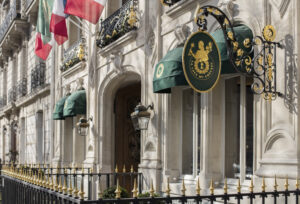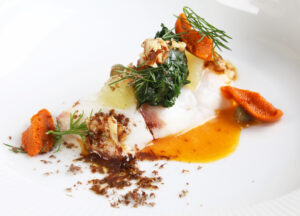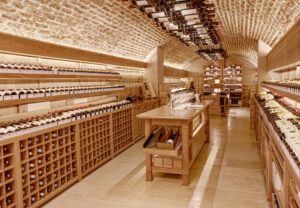
Le Clarence: Two-star food to match grand cru wine
Le Clarence restaurant in Paris combines two-star Michelin food with wines from Haut Brion, one of Bordeaux’s five most famous chateaux, writes Peter Ranscombe.
“THERE’S more that unites us than divides us”.
Those words were echoing through my mind as the Eurostar train hurtled through Northern France.
Looking out at the farms and fields, I could have been travelling through Aberdeenshire or Angus or East Lothian – although at a much faster speed.
The connection that farming communities have with their food is often hard to translate into cities and their restaurants.
Scots Andy Waugh and Calum Mackinnon have done it well in London with their Mac & Wild eateries, and the new Bonnie & Wild food hall at the St James Quarter in Edinburgh shows a lot of promise too.
What surprised me most about lunch at Le Clarence, a two Michelin star restaurant in Paris owned by Prince Robert of Luxembourg’s Domaine Clarence Dillon’s wine group, was how the restaurant maintained that link with its ingredients so that the dishes were the star of the show.
That’s no mean feat, considering the plush surrounding in which those dishes were served.
The mansion that houses Le Clarence on Avenue Franklin D Roosevelt – a hop, skip, and jump from the Champs-Élysées – began life in 1884 as the home and offices of an optician, complete with a stone-arched internal portico, allowing horse-drawn carriages to deposit their passengers without getting their hats wet.
Prince Robert was heavily involved in the restoration and decoration of the building before the restaurant opened in 2015, creating a similar look and feel to his property at Haut Brion, one of Bordeaux’s five first-growth chateaux, the region’s top classification.
The prince and his Domaine Clarence Dillon business are now involved in restoring the Grand Palais museum opposite the restaurant, a project that reminded me of the renovations at the National Museum of Scotland in Edinburgh, taking the building back to its frame.

What’s the food like at Le Clarence?
Just a year after opening, chef Christophe Pelé was awarded two stars by the Michelin guide for his food at Le Clarence, an honour he has maintained ever since.
For many diners, Michelin stars can equal fussy food, and Pelé’s dishes definitely have that distinctive look of high-end cuisine.
Yet that’s where the connection with his ingredients comes into play.
What keeps Pelé’s food tasty rather than fussy is his combination of flavours, with his style being described to us as bringing together unexpected ingredients.
Over five courses, we saw a creative take on “surf n’ turf” with grilled red mullet alongside a pig’s ear and shallot confit, we saw duck served with squid tempura and mullet bottarga, and we saw fried artichoke prepared with foie gras and haddock.
Each of the five courses was split into a main dish, surrounded by multiple accompaniments.
Highlights for me included the red mullet tartare served with a beef consomme, lemon caviar, and blueberry flower.
Perhaps the dishes that will stay with me the longest though were the excellent five-part desserts, including a bitter dark chocolate tart, a creme caramel enhanced with vanilla, and a mini waffle served with whipped cream and buckwheat honey.
From the side room in which we dined, guests could gaze across the courtyard to watch the brigade of chefs in their classic tall white hats preparing food in the kitchen.
The contrast between the modern dishes and the classical setting added to the sense of theatre.

What are the wines like at Le Clarence?
As well as Haut-Brion at Pessac-Leognan in the Graves region of the Medoc, Domaine Clarence Dillon also owns the neighbouring Château La Mission Haut-Brion, and – on the opposite bank – Château Quintus in Saint-Émilion and the nearby newly-acquired Château Grand-Pontet.
While the company’s estates naturally feature heavily on the wine list in the restaurant, bottles from throughout France are also served, along with a few foreign interlopers, courtesy of Premium Family Vini, the group of 12 family-owned wineries to which Domaine Clarence Dillon belongs.
What’s perhaps most exciting about the wine list though is the library of older vintages available – a great way to find a special bottle to match a special birthday or anniversary meal.
Over lunch, the opportunity to try a 2000 Château Haut-Brion alongside a 2000 Château La Mission Haut-Brion was a rare treat.
The Haut-Brion opened up beautifully to reveal silky tannins, heavy cedar and woodsmoke with some mushroom beginning, and surprisingly fresh acidity for its age.
I found La Mission chewier, with darker blackberry and blackcurrant flavours, yet it still had a real elegance and some lovely violet aromas once the heavier boot polish notes had blown off.
Worthy of a special mention though is the 2015 Clarendelle Amberwine, a sweet wine made in Monbazillac from a blend of 80% semillon and 20% muscadelle, similar to the famous dessert wines of Sauternes further down-river.
I’ve been impressed before by its combination of fresh acidity and sweet honey, red apple compote, and toasty biscuit notes.
While waiting to catch the Eurostar back to Blighty, there was the chance to wander and wonder around La Cave du Château, the restaurant’s accompanying wine shop, where bottles upstairs cost between €10 and €50, while those downstairs in the vaulted stone cellar include rare vintages of the domaine’s wines, alongside an impressive selection of Champagnes and other bottles.
A dose was definitely in order on the train back, but with sweet dreams of fine wines and creative modern dishes at the heart of classical Paris.
Read more of Peter’s wine, beer, and spirits reviews on his drinks blog, The Grape & The Grain

TAGS

